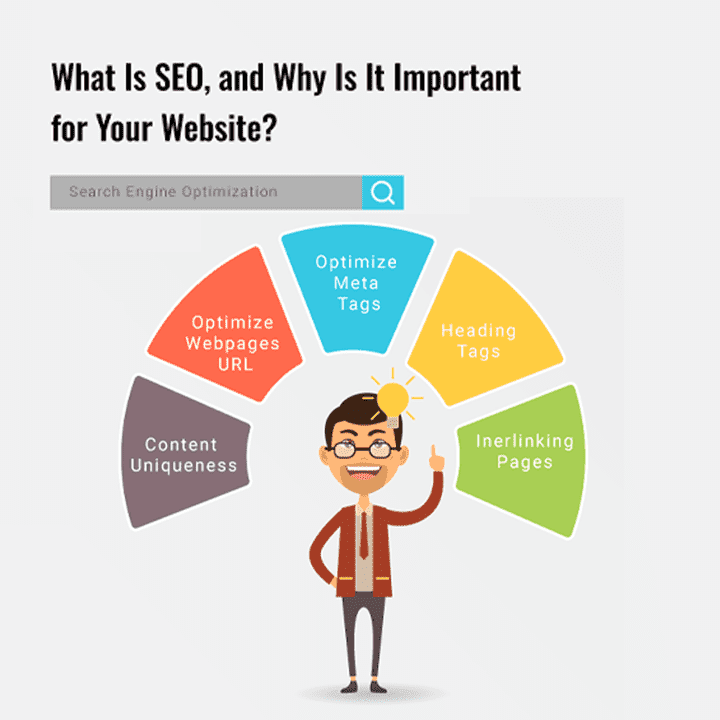
Basically, SEO is stand-alone search engine marketing. It’s a way to increase your website’s organic traffic on search engines by optimizing your website.
The primary goal of SEO is to increase organic traffic, improve visibility on search engine result pages, and build customer trust. Better user experience, worth, and brand awareness. SEO is an ongoing process, and we can work on it on a daily basis for better improvement and to rank keywords in search engines.
Main components of SEO
Mainly there are two components of SEO but some specialists categorize SEO into three distinctive parts.
On-page SEO
First, we discuss on-page SEO, also known as on-site SEO. In this process, we optimize your website design according to search engine or user perspectives. On-page SEO has multiple tasks, like website structure, website content, meta tags, heading tags, URL optimization, and internal-external linking.
Off-page SEO
Now we talk about off-page SEO, also known as off-site SEO. In this process, we work outside of our main website to improve the website’s reputation and ranking. In off-page SEO, we have tasks like link building, guest blogging, social media marketing, and more. The goal of off-page SEO is to get users to see your site everywhere and build trust.
Technical SEO
Technical SEO is the process of ensuring that our website is meeting the modern requirements of Search engine result pages that leads to increase in organic traffic and visibility that mainly involves the optimization of url ,aiming to make it more user-friendly, improve its loading speed, and fix Google search console.
Why is it important for your website?
If you want more business leads and more organic traffic on your website, then you need to do SEO on it. SEO makes sure that the website has the best user experience and is optimized according to Google algorithms. then your website ranks in the search engine.
The Google algorithm is constantly changing, but Google always prioritizes content quality and user experience. If your content is unique and users have read it or spent some time on it, Google will prioritize it.
How to Rank Your Website on Search Engines
If you want your website to be at the top of the search engine, then you need to remember these points:
- Content Uniqueness: Make sure your website or webpage content is unique or helpful. Also, make sure your content is user-friendly or relevant to the query.
- Optimize Web pages URL: Always check and optimize the URL with your keyword, and avoid the special characters in the URL like:!,@,#,$,_. That’s a very small mistake, but one little mistake prevents your website from ranking.
- Optimize Meta Tags: Always optimize your meta tags with your focus page keyword, and according to your webpage, make sure the title length is under 60 characters and the description length is 160 characters because on the search engine result page, the first 60 characters and the description are the first 160 characters, and you can add one call to action on your meta tag, like buy, free offer, grab it, etc., according to your niche.
- Heading Tags: The heading tags are also important for the SEO process; we need to optimize one H1 tag on a single webpage. The heading tags are six variables, like H1, H2, H3, H4, H5, and H6. The higher the H tag, the more Google gives it importance.
- Interlinking Pages: You can use interlinking on your website to refer from one page to another page for better crawling or user experience.
- Alt Tags: alt tags, also known as alternative tags or alt text, In this process, we optimize images for search engines. because search engines never read images; they can read their names, and then they can rank those images in the image section.
- Page Loading Speed: If your website is well-stretched and the content is good but the loading speed is so low that users will never stay on it, make sure the loading speed is well optimized.
- Duplicate Content: If you have a product-base website, then you have multiple pages with similar or duplicate content. Now you can use the Canonical tag to remove duplication or tell the search engine that this is the main master URL so you can index it.
- Off-page SEO: First, if our website is well optimized, half of the work is done. Now we can move on to off-page SEO.
In this phase, our main focus is to create high-quality backlinks with trustworthy websites for better crawling, traffic, and trust.
In this phase, we perform various tasks, like social bookmarking and profile creation. Directory Submission, PPT Submission, PDF Submission, Web 2.0 Backlink, Blog Submission, Article Submission, Classified Ads, Press Release Submission, Video Submission, Quora Submission (Q&A), Competitor Backlinks, Podcast Submission, Business Listing, Reddit Posts, Infographic Sharing, Image Sharing, Blog Promotion, Guest Post, Micro Blogging, Brand Promotion, Article Promotion, Banner Creation and Sharing, and Video Promotion are the all-page tasks.
In off-page SEO, we can use content marketing to publish high-quality and informative content to earn backlinks and EAT (expertise, authoritativeness, and trustworthiness). In content marketing, we have to do blog articles, guest posts, or press releases.
Conclusions
As I mentioned at the start, SEO work will be divided into two phases: on-page and off-page. On-page is a one-time process, whereas off-page is ongoing. If you work for a certain period and then pause, our previous efforts will go in vain. SEO off-page is an ongoing process, and we can work on a daily basis on off-page SEO for better improvement and to rank keywords. SEO is a lot of effort and time-consuming because search engines change their algorithms day by day, month by month, or week by week. So we need to prepare for every update, accept the update, and change or standardize according to the update, and then we will last long on top of every search engine.
